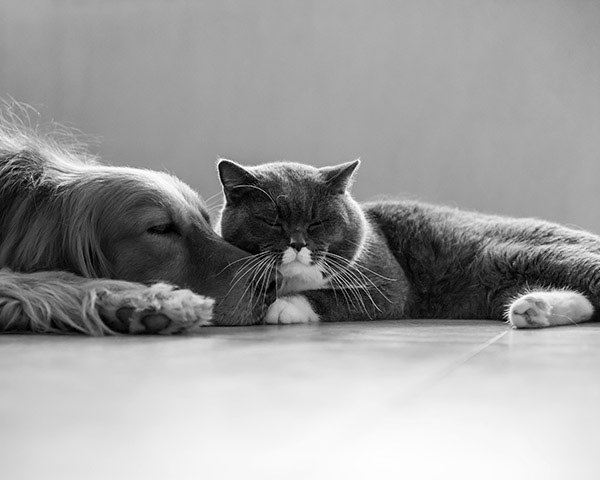Cavalier King Charles Spaniel dog breed information and advice
Regal in name and cute as a button, the Cavalier King Charles Spaniel could be the perfect little lap dog to introduce to your family. They do have a reputation for having zoomies every now and again, but their affectionate nature makes them a perfect fit for any home.
This dog breed guide gives the information you need on how to care for a Cavalier King Charles Spaniel. From diet and grooming tips, to exercise and common health issues.
Cavalier King Charles Spaniel facts

| Lifespan | 9 – 15 years |
| How much | £700 – £2,500 |
| Size | 30 – 33 cm |
| Weight | 6 – 8 kg |
| Colours | Black and tan, ruby, Blenheim, tricolour – black and white broken up with tan markings |
| Grooming | Once a week |
| Temperament | Affectionate, playful, patient |
| Exercise | 30 – 60 minutes |
Pet insurance for your Cavalier King Charles Spaniel
No one wants a poorly pet, but unfortunately, illnesses and injuries can happen to any dog. Dog insurance for your Cavalier King Charles can help with the cost of vet fees and medication, should your pooch get ill.
Cavalier King Charles Spaniels can be more prone to developing certain health conditions, including:
Regular health checks with your vet will help to spot problems from an early stage.
Sainsbury’s Bank Pet Insurance
With Sainsbury's Bank Pet Insurance we can insure your Cavalier King Charles from as young as eight weeks of age. We offer three levels of insurance cover to suit your needs and budget:
• Lifetime – our most comprehensive cover with up to £10,000 towards vet costs each year.
• Maximum benefit – cover for up to £6,000 per year.
• Time limited – covers your Cavalier King Charles with vet costs for short-term health conditions of up to £3,000, or for 12 months.
Please be aware that we won't cover any pre-existing conditions and that terms, conditions, excesses, exclusions and limitations apply.
How to care for a Cavalier King Charles Spaniel
Knowing how to give your Cavalier King Charles the right care will help them lead a full and happy life.
Feeding and nutrition
A Cavalier King Charles Spaniel puppy needs to be fed three to four times a day. If you can, try to stick to the same type of food and feeding schedule as the breeder as changing from this too soon can lead to an upset tummy.
As they get older a Cavalier King Charles Spaniel should be fed two to three times a day. As a breed, Cavaliers can be picky eaters and would much prefer to eat treats than their dog food. To get your dog to eat, make sure you set strict feeding times.
Put the bowl down at the same time every day and only leave it down for a short time, say ten minutes. If your dog doesn’t eat the food in that time, don’t be tempted to leave it down for longer, or to feed it something else instead. Your dog will quickly learn that they’re not going to get anything else and will eventually get hungry enough to eat their food.
If you follow the tips above, mealtimes will get easier to manage. Stick to dog food only and don’t try to tempt them with treats to get them to eat. Too many treats can lead to weight gain and health problems.
Grooming
Cavalier King Charles Spaniels have a double coat; a topcoat of long hair that’s soft, and a thick undercoat. Brushing your dog every week will help to get rid of any fur that’s shedding and keep their coat smooth and silky. This’ll also help stop their fur from getting tangled or matted.
You’ll need to bath your dog once a month to get rid of the doggy smell and to keep their coat clean. Only wash them more often than that if your dog gets dirty or rolls in something smelly. Tear stains are common in Cavalier King Charles Spaniels, but if you’re worried speak to your vet. Regularly wipe your dog’s eyes with a clean damp cloth to reduce the staining and help prevent any eye related problems.
Exercise
They may be small in size, but the Cavalier King Charles Spaniel has the same sporting nature as other Spaniel breeds. You’ll need to exercise your dog for 30 to 60 minutes daily and walking your dog is the best form of exercise. In secure areas, give your dog the chance to run around off lead for a more energetic workout.
Training
The Cavalier King Charles is an easy breed to train. They’re patient, obedient and keen to please their owner. But if you’re having difficulty, training classes can offer practical guidance, tips and support.
When you take your puppy home, start house training as soon as possible. Give your dog lots of chances to go to the toilet outside, letting them out before they show signs of needing to go. They’ll soon get into the routine of only going to the toilet when you let them out.
Temperament and behaviour
This breed’s temperament ranges from sweet and placid to determined and stubborn. They need plenty of exercise and mental stimulation, but at the end of the day, they love to curl up on your lap. They’re affectionate with a playful personality that will keep you entertained for hours, making them the perfect addition to any family.
Common health problems
There are common health problems linked to this breed, which if left untreated could shorten their lifespan. Pet insurance can help cover the cost of vet bills, so you shouldn't have to worry about paying too much for treatment. Changes in behaviour could be a sign that something’s wrong, so take them to your vet if you’re concerned.
Mitral valve disease
This is the most common cause of heart murmurs in dogs. Mitral valves ensure the blood always flows in the right direction through the heart. If the valves fail to develop properly, or they’re affected by infections, blood can leak between the heart chambers, making the heart beat faster and harder. This will eventually lead to heart failure. Medication and surgery can treat the problem, depending on how severe it is.
Luxating patella
Dogs affected by this condition will hop on one of their back legs, with the other held up. They do this because the kneecap or ‘patella’ is unstable and jumps out of the groove it’s supposed to sit in. Most sufferers of a luxating patella will need surgery to realign the kneecap and cut the groove deeper.
Epilepsy
If your dog has more than one fit, they could have epilepsy. It’s caused by abnormal brain activity and will most likely happen when your dog is relaxed. During the fit, your dog may fall on its side, cry out, or lose control of their bowels or bladder. The condition can’t be cured but it can be managed with tablets, allowing your dog to live a long fulfilling life.
Syringomyelia (Chiari-like malformation)
This genetically inherited condition affects dogs under the age of six years. Cyst-like lesions develop in the dog’s spinal cord, causing pain and abnormal movements. The cysts can expand over time, destroying the spinal cord. Signs of the condition include twisting of the neck, scratching of the neck and shoulder, yelping for no apparent reason, and lameness of the front limbs. Currently, there’s no standard treatment for this condition. Surgery has shown the best results, but the outcome depends on the severity and age of the dog. The Chiari Malformation / Syringomyelia Scheme was developed to help breeders screen their dogs before breeding them.
So, is a Cavalier King Charles Spaniel right for you?
This outgoing dog breed is adaptable to city or country living. Just make sure they get the exercise they need, or mad five-minute zoomies will be a common event. Give them the long walks and playtime they love and they’ll reward you with plenty of affection and cuddles.
If you can offer a Cavalier King Charles Spaniel the active and fun-filled lifestyle that they crave, then this might be the right pooch for you.
Frequently asked questions
What’s the difference between a Cavalier King Charles Spaniel and a King Charles Spaniel?
While both breeds look very similar and have similar names, they are two different breeds. The King Charles Spaniel is a slightly smaller dog, with a dome shaped head and shorter snout. It needs a bit more exercise and mental stimulation than a Cavalier as they have a touch more energy.
Are Cavalier King Charles Spaniels hyper?
Cavalier King Charles Spaniels can be hyper and have dog zoomies if they don’t get the exercise they need. If you walk them for 30 to 60 minutes daily, they’ll happily cuddle up with you for the rest of the day and won’t demand too much attention.
Do Cavalier King Charles Spaniels shed?
Cavalier King Charles Spaniels have a double coat that sheds a lot. You’ll need to brush your dog weekly to keep their coat tangle-free and to remove any loose fur.
How to get a Cavalier King Charles Spaniel to eat
Cavalier King Charles Spaniels are fussy eaters. Their weight should be between 6-8 kg, but this can be difficult to maintain if your dog isn’t eating all their food. If your dog is being fussy at mealtimes, you’ll need to limit the number of treats in their diet and set strict feeding times.

Browse our guides
Choose from our list of helpful guides and information

Explore dog breeds
Find out how to keep your dog healthy and happy

Cat breed guides
How to care for your cat, common health problems and more
Terms and conditions
Important information
Sainsbury's Bank plc, Registered Office, 33 Charterhouse Street, London, EC1M 6HA (registered in England and Wales, no 3279730) is authorised by the Prudential Regulation Authority and regulated by the Financial Conduct Authority and the Prudential Regulation Authority (register no. 184514).
Sainsbury's Supermarkets Ltd is an appointed representative of Sainsbury's Bank plc. Sainsbury's Bank plc acts as an introducer to Pinnacle Insurance Ltd who is authorised by the Prudential Regulation Authority and regulated by the Financial Conduct Authority and the Prudential Regulation Authority (register number 110866). Registered office: 4th Floor, Limelight, Elstree Way, Borehamwood, Hertfordshire, WD6 1JH. Sainsbury’s Bank Pet Insurance is arranged, administered and underwritten by Pinnacle Insurance Ltd. Sainsbury's Bank plc and Pinnacle Insurance Ltd are not part of the same corporate group.
We do not provide personal recommendations to customers.
